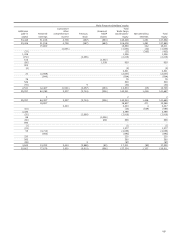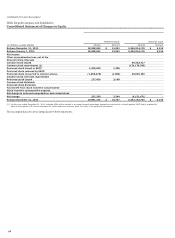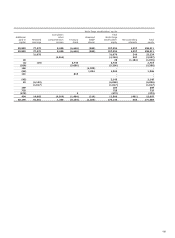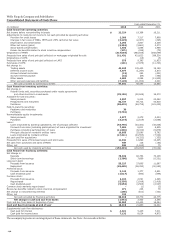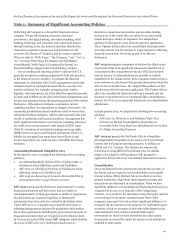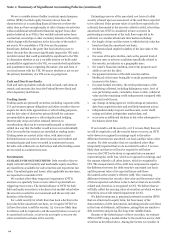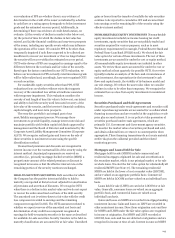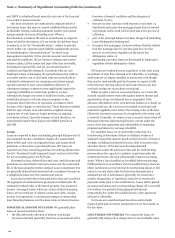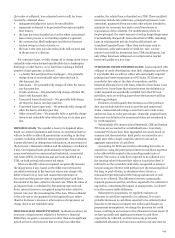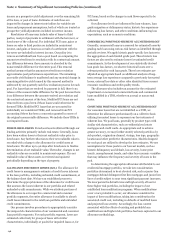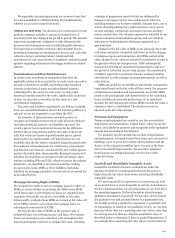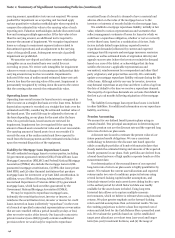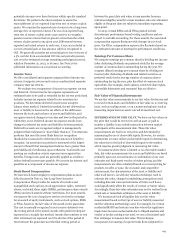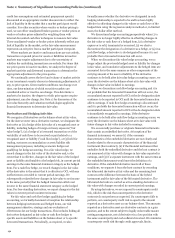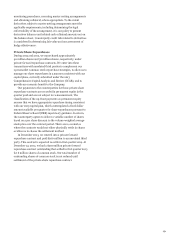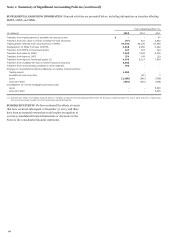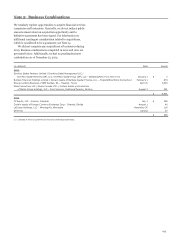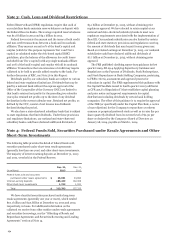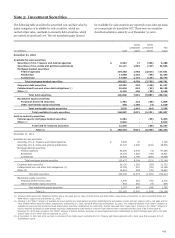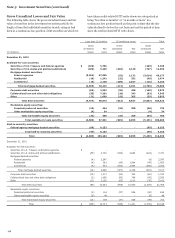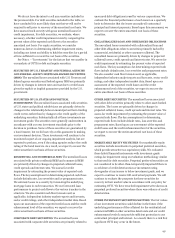Wells Fargo 2013 Annual Report Download - page 149
Download and view the complete annual report
Please find page 149 of the 2013 Wells Fargo annual report below. You can navigate through the pages in the report by either clicking on the pages listed below, or by using the keyword search tool below to find specific information within the annual report.We separately estimate impairment for consumer loans that
have been modified in a TDR (including trial modifications),
whether on accrual or nonaccrual status.
OTHER ACL MATTERS The allowance for credit losses for both
portfolio segments includes an amount for imprecision or
uncertainty that may change from period to period. This amount
represents management’s judgment of risks inherent in the
processes and assumptions used in establishing the allowance.
This imprecision considers economic environmental factors,
modeling assumptions and performance, process risk, and other
subjective factors, including industry trends and risk
assessments for our commitments to regulatory and government
agencies regarding settlements of mortgage foreclosure-related
matters.
Securitizations and Beneficial Interests
In certain asset securitization transactions that meet the
applicable criteria to be accounted for as a sale, assets are sold to
an entity referred to as an SPE, which then issues beneficial
interests in the form of senior and subordinated interests
collateralized by the assets. In some cases, we may retain
beneficial interests issued by the entity. Additionally, from time
to time, we may also re-securitize certain assets in a new
securitization transaction.
The assets and liabilities transferred to an SPE are excluded
from our consolidated balance sheet if the transfer qualifies as a
sale and we are not required to consolidate the SPE.
For transfers of financial assets recorded as sales, we
recognize and initially measure at fair value all assets obtained
(including beneficial interests) and liabilities incurred. We
record a gain or loss in noninterest income for the difference
between the carrying amount and the fair value of the assets
sold. Fair values are based on quoted market prices, quoted
market prices for similar assets, or if market prices are not
available, then the fair value is estimated using discounted cash
flow analyses with assumptions for credit losses, prepayments
and discount rates that are corroborated by and verified against
market observable data, where possible. Retained interests and
liabilities incurred from securitizations with off-balance sheet
entities, including SPEs and VIEs, where we are not the primary
beneficiary, are classified as investment securities, trading
account assets, loans, MSRs or other liabilities (including
liabilities for mortgage repurchase losses) and are accounted for
as described herein.
Mortgage Servicing Rights (MSRs)
We recognize the rights to service mortgage loans for others, or
MSRs, as assets whether we purchase the MSRs or the MSRs
result from a sale or securitization of loans we originate (asset
transfers). We initially record all of our MSRs at fair value.
Subsequently, residential loan MSRs are carried at fair value. All
of our MSRs related to our commercial mortgage loans are
subsequently measured at LOCOM.
We base the fair value of MSRs on the present value of
estimated future net servicing income cash flows. We estimate
future net servicing income cash flows with assumptions that
market participants would use to estimate fair value, including
estimates of prepayment speeds (which are influenced by
changes in mortgage interest rates and borrower behavior,
including estimates for borrower default), discount rates, cost to
service (including delinquency and foreclosure costs), escrow
account earnings, contractual servicing fee income, ancillary
income and late fees. Our valuation approach is validated by our
internal valuation model validation group, and our valuation
estimates are benchmarked to third party appraisals on a
quarterly basis.
Changes in the fair value of MSRs occur primarily due to the
collection/realization of expected cash flows, as well as changes
in valuation inputs and assumptions. For MSRs carried at fair
value, changes in fair value are reported in noninterest income in
the period in which the change occurs. MSRs subsequently
measured at LOCOM are amortized in proportion to, and over
the period of, estimated net servicing income. The amortization
of MSRs is reported in noninterest income, analyzed monthly
and adjusted to reflect changes in prepayment speeds, as well as
other factors.
MSRs accounted for at LOCOM are periodically evaluated for
impairment based on the fair value of those assets. For purposes
of impairment evaluation and measurement, we stratify MSRs
based on the predominant risk characteristics of the underlying
loans, including investor and product type. If, by individual
stratum, the carrying amount of these MSRs exceeds fair value, a
valuation reserve is established. The valuation reserve is
adjusted as the fair value changes.
Premises and Equipment
Premises and equipment are carried at cost less accumulated
depreciation and amortization. Capital leases, where we are the
lessee, are included in premises and equipment at the capitalized
amount less accumulated amortization.
We primarily use the straight-line method of depreciation
and amortization. Estimated useful lives range up to 40 years for
buildings, up to 10 years for furniture and equipment, and the
shorter of the estimated useful life (up to 8 years) or the lease
term for leasehold improvements. We amortize capitalized
leased assets on a straight-line basis over the lives of the
respective leases.
Goodwill and Identifiable Intangible Assets
Goodwill is recorded in business combinations under the
purchase method of accounting when the purchase price is
higher than the fair value of net assets, including identifiable
intangible assets.
We assess goodwill for impairment at a reporting unit level
on an annual basis or more frequently in certain circumstances.
We have determined that our reporting units are one level below
the operating segments. We have the option of performing a
qualitative assessment of goodwill. We may also elect to bypass
the qualitative test and proceed directly to a quantitative test.
We initially perform a qualitative assessment of goodwill to test
for impairment. If, based on our qualitative review, we conclude
that more likely than not a reporting unit’s fair value is less than
its carrying amount, then we complete quantitative steps as
described below to determine if there is goodwill impairment. If
we conclude that a reporting unit’s fair value is not less than its
147


